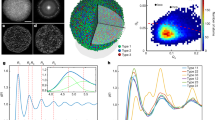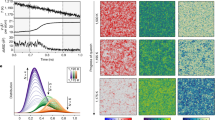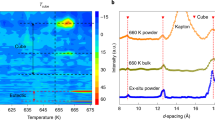Abstract
Liquids and solids are two fundamental states of matter. However, our understanding of their three-dimensional atomic structure is mostly based on physical models. Here we use atomic electron tomography to experimentally determine the three-dimensional atomic positions of monatomic amorphous solids, namely a Ta thin film and two Pd nanoparticles. We observe that pentagonal bipyramids are the most abundant atomic motifs in these amorphous materials. Instead of forming icosahedra, the majority of pentagonal bipyramids arrange into pentagonal bipyramid networks with medium-range order. Molecular dynamics simulations further reveal that pentagonal bipyramid networks are prevalent in monatomic metallic liquids, which rapidly grow in size and form more icosahedra during the quench from the liquid to the glass state. These results expand our understanding of the atomic structures of amorphous solids and will encourage future studies on amorphous–crystalline phase and glass transitions in non-crystalline materials with three-dimensional atomic resolution.
This is a preview of subscription content, access via your institution
Access options
Access Nature and 54 other Nature Portfolio journals
Get Nature+, our best-value online-access subscription
$29.99 / 30 days
cancel any time
Subscribe to this journal
Receive 12 print issues and online access
$259.00 per year
only $21.58 per issue
Buy this article
- Purchase on Springer Link
- Instant access to full article PDF
Prices may be subject to local taxes which are calculated during checkout






Similar content being viewed by others
Data availability
The raw and processed experimental data are available at https://github.com/AET-AmorphousMaterials/Supplementary-Data-Codes. The 3D atomic coordinates of the Ta thin film and Pd1 and Pd2 nanoparticles have been deposited in the Materials Data Bank (www.materialsdatabank.org) with Materials Data Bank identification numbers TaXX00001, PdXX00001 and PdXX00002, respectively.
Code availability
The MATLAB source codes for the RESIRE reconstruction and data analysis used in this work are available at https://github.com/AET-AmorphousMaterials/Supplementary-Data-Codes.
References
Frank, F. C. Supercooling of liquids. Proc. R. Soc. Lond. A 215, 43–46 (1952).
Bernal, J. D. A geometrical approach to the structure of liquids. Nature 183, 141–147 (1959).
Scott, G. D. Packing of spheres: packing of equal spheres. Nature 188, 908–909 (1960).
Finney, J. L. Random packings and the structure of simple liquids. I. The geometry of random close packing. Proc. R. Soc. Lond. A 319, 479–493 (1970).
Nelson, D. R. Order, frustration, and defects in liquids and glasses. Phys. Rev. B 28, 5515–5535 (1983).
Jonsson, H. & Andersen, H. C. Icosahedral ordering in the Lennard-Jones liquid and glass. Phys. Rev. Lett. 60, 2295–2298 (1988).
Chen, L. C. & Spaepen, F. Calorimetric evidence for the micro-quasicrystalline structure of ‘amorphous’ Al/transition metal alloys. Nature 336, 366–368 (1988).
Reichert, H. et al. Observation of five-fold local symmetry in liquid lead. Nature 408, 839–841 (2000).
Spaepen, F. Five-fold symmetry in liquids. Nature 408, 781–782 (2000).
Kelton, K. F. et al. First X-ray scattering studies on electrostatically levitated metallic liquids: demonstrated influence of local icosahedral order on the nucleation barrier. Phys. Rev. Lett. 90, 195504 (2003).
Schenk, T., Holland-Moritz, D., Simonet, V., Bellissent, R. & Herlach, D. M. Icosahedral short-range order in deeply undercooled metallic melts. Phys. Rev. Lett. 89, 075507 (2002).
Jakse, N. & Pasturel, A. Local order of liquid and supercooled zirconium by ab initio molecular dynamics. Phys. Rev. Lett. 91, 195501 (2003).
Di Cicco, A., Trapananti, A., Faggioni, S. & Filipponi, A. Is there icosahedral ordering in liquid and undercooled metals? Phys. Rev. Lett. 91, 135505 (2003).
Stratton, W. G. et al. Aluminum nanoscale order in amorphous Al92Sm8 measured by fluctuation electron microscopy. Appl. Phys. Lett. 86, 141910 (2005).
Anikeenko, A. V. & Medvedev, N. N. Polytetrahedral nature of the dense disordered packings of hard spheres. Phys. Rev. Lett. 98, 235504 (2007).
Ma, D., Stoica, A. D. & Wang, X. L. Power-law scaling and fractal nature of medium-range order in metallic glasses. Nat. Mater. 8, 30–34 (2009).
Dmowski, W., Iwashita, T., Chuang, C. P., Almer, J. & Egami, T. Elastic heterogeneity in metallic glasses. Phys. Rev. Lett. 105, 205502 (2010).
Hirata, A. et al. Direct observation of local atomic order in a metallic glass. Nat. Mater. 10, 28–33 (2011).
Zhong, L., Wang, J., Sheng, H., Zhang, Z. & Mao, S. X. Formation of monatomic metallic glasses through ultrafast liquid quenching. Nature 512, 177–180 (2014).
Ding, J. & Ma, E. Computational modeling sheds light on structural evolution in metallic glasses and supercooled liquids. npj Comput. Mater. 3, 9 (2017).
Tanaka, H., Tong, H., Shi, R. & Russo, J. Revealing key structural features hidden in liquids and glasses. Nat. Rev. Phys. 1, 333–348 (2019).
Khmicha, A., Sbiaaib, K. & Hasnaouib, A. Structural behavior of tantalum monatomic metallic glass. J. Non-Cryst. Solids 510, 81–92 (2019).
Gemma, R., Baben, M., Pundt, A., Kapaklis, V. & Hjörvarsson, B. The impact of nanoscale compositional variation on the properties of amorphous alloys. Sci. Rep. 10, 11410 (2020).
Nelson, D. R. & Spaepen, F. Polytetrahedral order in condensed matter. Solid Stat. Phys. 42, 1–90 (1989).
Sheng, H. W., Luo, W. K., Alamgir, F. M., Bai, J. M. & Ma, E. Atomic packing and short-to-medium-range order in metallic glasses. Nature 439, 419–425 (2006).
Cheng, Y. Q. & Ma, E. Atomic-level structure and structure–property relationship in metallic glasses. Prog. Mater. Sci. 56, 379–473 (2011).
Chen, M. W. A brief overview of bulk metallic glasses. NPG Asia Mater. 3, 82–90 (2011).
Luo, W. K. et al. Icosahedral short-range order in amorphous alloys. Phys. Rev. Lett. 92, 145502 (2004).
Hirata, A. et al. Geometric frustration of icosahedron in metallic glasses. Science 341, 376–379 (2013).
Shechtman, D., Blech, I., Gratias, D. & Cahn, J. Metallic phase with long-range orientational order and no translational symmetry. Phys. Rev. Lett. 53, 1951–1953 (1984).
Levine, D. & Steinhardt, P. J. Quasicrystals: a new class of ordered structures. Phys. Rev. Lett. 53, 2477–2480 (1984).
Miao, J., Ercius, P. & Billinge, S. J. L. Atomic electron tomography: 3D structures without crystals. Science 353, aaf2157 (2016).
Scott, M. C. et al. Electron tomography at 2.4-ångström resolution. Nature 483, 444–447 (2012).
Chen, C. C. et al. Three-dimensional imaging of dislocations in a nanoparticle at atomic resolution. Nature 496, 74–77 (2013).
Goris, B. et al. Three-dimensional elemental mapping at the atomic scale in bimetallic nanocrystals. Nano Lett. 13, 4236–4241 (2013).
Xu, R. et al. Three-dimensional coordinates of individual atoms in materials revealed by electron tomography. Nat. Mater. 14, 1099–1103 (2015).
Haberfehlner, G. et al. Formation of bimetallic clusters in superfluid helium nanodroplets analysed by atomic resolution electron tomography. Nat. Commun. 6, 8779 (2015).
Yang, Y. et al. Deciphering chemical order/disorder and material properties at the single-atom level. Nature 542, 75–79 (2017).
Zhou, J. et al. Observing crystal nucleation in four dimensions using atomic electron tomography. Nature 570, 500–503 (2019).
Tian, X. et al. Correlating the three-dimensional atomic defects and electronic properties of two-dimensional transition metal dichalcogenides. Nat. Mater. 19, 867–873 (2020).
Kim, B. H. et al. Critical differences in 3D atomic structure of individual ligand-protected nanocrystals in solution. Science 368, 60–67 (2020).
Yang, Y. et al. Determining the three-dimensional atomic structure of an amorphous solid. Nature 592, 60–64 (2021).
Egami, T. & Billinge, S. J. L. Underneath the Bragg Peaks: Structural Analysis of Complex Materials 2nd edn, Vol. 16 (Pergamon Materials Series, Pergamon-Elsevier Science, 2012).
Lechner, W. & Dellago, C. Accurate determination of crystal structures based on averaged local bond order parameters. J. Chem. Phys. 129, 114707 (2008).
Lee, G. W. et al. Difference in icosahedral short-range order in early and late transition metal liquids. Phys. Rev. Lett. 93, 037802 (2004).
Hales, T. C. A proof of the Kepler conjecture. Ann. Math. 162, 1065–1185 (2005).
Plimpton, S. Fast parallel algorithms for short-range molecular dynamics. J. Comput. Phys. 117, 1–19 (1995).
Tang, C. & Harrowell, P. Anomalously slow crystal growth of the glass-forming alloy CuZr. Nat. Mater. 12, 507–511 (2013).
Ohring, M. Materials Science of Thin Films 2nd edn (Academic Press, 2001).
Liu, A. J. & Nagel, S. R. Jamming is not just cool any more. Nature 396, 21–22 (1998).
Kelton, K. F. & Greer, A. L. Nucleation in Condensed Matter: Applications in Materials and Biology (Pergamon, 2010).
Debenedetti, P. G. & Stillinger, F. H. Supercooled liquids and the glass transition. Nature 410, 259–267 (2001).
Liu, Y. et al. Surfactant-induced postsynthetic modulation of Pd nanoparticle crystallinity. Nano Lett. 11, 1614–1617 (2011).
Kim, S.-W. et al. Synthesis of monodisperse palladium nanoparticles. Nano Lett. 3, 1289–1291 (2003).
Nag, A. et al. Metal-free inorganic ligands for colloidal nanocrystals: S2–, HS–, Se2–, HSe–, Te2–, HTe–, TeS32–, OH–, and NH2– as surface ligands. J. Am. Chem. Soc. 133, 10612–10620 (2011).
Zheng, K. et al. Electron-beam-assisted superplastic shaping of nanoscale amorphous silica. Nat. Commun. 1, 24 (2010).
Cao, C. R. et al. Liquid-like behaviours of metallic glassy nanoparticles at room temperature. Nat. Commun. 10, 1966 (2019).
Tran, D. T., Svensson, G. & Tai, C. W. SUePDF: a program to obtain quantitative pair distribution functions from electron diffraction data. J. Appl. Crystallogr. 50, 304–312 (2017).
Billinge, S. J. L. The rise of the X-ray atomic pair distribution function method: a series of fortunate events. Phil. Trans. R. Soc. A 377, 20180413 (2019).
Dabov, K., Foi, A., Katkovnik, V. & Egiazarian, K. Image denoising by sparse 3-D transform-domain collaborative filtering. IEEE Trans. Image Process. 16, 2080–2095 (2007).
Rogers, S. S., Waigh, T. A., Zhao, X. & Lu, J. R. Precise particle tracking against a complicated background: polynomial ftting with Gaussian weight. Phys. Biol. 4, 220–227 (2007).
Lloyd, S. Least squares quantization in PCM. IEEE Trans. Inf. Theory 28, 129–137 (1982).
Brünger, A. T. et al. Crystallography & NMR System: a new software suite for macromolecular structure determination. Acta Crystallogr. D 54, 905–921 (1998).
Ophus, C. A fast image simulation algorithm for scanning transmission electron microscopy. Adv. Struct. Chem. Imag. 3, 13 (2017).
Pryor, A., Ophus, C. & Miao, J. A streaming multi-GPU implementation of image simulation algorithms for scanning transmission electron microscopy. Adv. Struct. Chem. Imag. 3, 15 (2017).
Steinhardt, P. J., Nelson, D. R. & Ronchetti, M. Bond-orientational order in liquids and glasses. Phys. Rev. B 28, 784–805 (1983).
Ravelo, R., Germann, T. C., Guerrero, O., An, Q. & Holian, B. L. Shock-induced plasticity in tantalum single crystals: interatomic potentials and large-scale molecular-dynamics simulations. Phys. Rev. B 88, 134101 (2013).
Purja Pun, G. P., Darling, K. A., Kecskes, L. J. & Mishin, Y. Angular-dependent interatomic potential for the Cu–Ta system and its application to structural stability of nano-crystalline alloys. Acta Mater. 100, 377–391 (2015).
Acknowledgements
We thank J. Ciston for help with data acquisition and X. Tian for help with data analysis. This work was primarily supported by the US Department of Energy, Office of Science, Basic Energy Sciences, Division of Materials Sciences and Engineering under award no. DE-SC0010378. We also thank the support by STROBE: a National Science Foundation Science and Technology Center under award no. DMR-1548924. Some of the data analysis was partially supported by the National Science Foundation Designing Materials to Revolutionize and Engineer our Future (DMREF) programme under award no. DMR-1437263 and the Army Research Office Multidisciplinary University Research Initiative (MURI) programme under grant no. W911NF-18-1-0431. The ADF-STEM imaging with TEAM I was performed at the Molecular Foundry, which is supported by the Office of Science, Office of Basic Energy Sciences of the US Department of Energy under contract no. DE-AC02-05CH11231.
Author information
Authors and Affiliations
Contributions
J.M. conceived the idea and directed the project; A.K.S. synthesized the amorphous Ta thin film; Y.N. and O.C. synthesized the amorphous Pd nanoparticles; J.Z., A.K.S., P.E. and J.M. discussed and performed the AET experiments of the amorphous materials; and M.P., Y. Yuan, S.J.O. and J.M. developed the 3D reconstruction algorithm. Y. Yuan, D.S.K., D.J.C., F.Z., Y. Yang and J.M. performed image reconstruction and atom tracing, analysed the data and interpreted the results; D.S.K. and J.M. discussed and performed the MD simulations. Y. Yuan, D.S.K. and J.M. wrote the manuscript. All authors commented on the manuscript.
Corresponding author
Ethics declarations
Competing interests
The authors declare no competing interests.
Additional information
Peer review information Nature Materials thanks Matthew Kramer and Yong Yang for their contribution to the peer review of this work.
Publisher’s note Springer Nature remains neutral with regard to jurisdictional claims in published maps and institutional affiliations.
Supplementary information
Supplementary Information
Supplementary Table 1 and Figs. 1–22.
Supplementary Video 1
Experimental 3D atomic model of the amorphous Ta thin film. The reconstructed volume of the thin film consists of 6,615 disordered atoms (in blue) with several crystal nuclei of 1,669 atoms on the surface (in grey).
Supplementary Video 2
Experimental 3D atomic model of the amorphous Pd1 nanoparticle. The nanoparticle consists of 51,170 disordered atoms (in green) with several small crystal nuclei of 1,138 atoms on the surface (in grey).
Supplementary Video 3
Experimental 3D atomic model of the amorphous Pd2 nanoparticle. The nanoparticle consists of 74,893 disordered atoms (in green) with several small crystal nuclei of 1,345 atoms on the surface (in grey).
Rights and permissions
About this article
Cite this article
Yuan, Y., Kim, D.S., Zhou, J. et al. Three-dimensional atomic packing in amorphous solids with liquid-like structure. Nat. Mater. 21, 95–102 (2022). https://doi.org/10.1038/s41563-021-01114-z
Received:
Accepted:
Published:
Issue Date:
DOI: https://doi.org/10.1038/s41563-021-01114-z
This article is cited by
-
Self-assembled soft alloy with Frank–Kasper phases beyond metals
Nature Materials (2024)
-
Three-dimensional atomic structure and local chemical order of medium- and high-entropy nanoalloys
Nature (2023)
-
Probing the atomically diffuse interfaces in Pd@Pt core-shell nanoparticles in three dimensions
Nature Communications (2023)
-
Accurate real space iterative reconstruction (RESIRE) algorithm for tomography
Scientific Reports (2023)
-
Hierarchical amorphous ordering in colloidal gelation
Nature Physics (2023)



